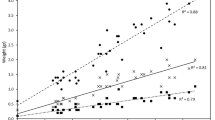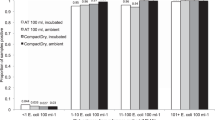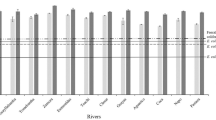Abstract
SMITH1 determined the incidence of antibiotic resistant coliform bacteria in various rivers, paying particular attention to Escherichia coli with transmissible resistance to chloramphenicol; this resistance is potentially dangerous because it may be transferable to Salmonella typhi and so render the treatment of typhoid fever more difficult. An important conclusion that emerged from his work was that most of the antibiotic resistant coliforms and R+ E. coli in rivers examined came from urban sewage. These types were present even in sewage from areas with no abattoirs; human beings were thus shown to be the main source of antibiotic resistant types in the rivers. Smith2 subsequently determined the incidence of antibiotic resistant coliforms and R+ E. coli in coastal bathing waters and reported that the ratio of the concentrations of the different kinds of antibiotic resistant coliform organisms to each other and to the antibiotic sensitive organisms in the seawater resembled that in human sewage previously examined1. He concluded2 that R+ E. coli in seawater provided “stronger evidence of contamination with human sewage”, and that “the present undesirable situation could be corrected immediately if proper disposal of sewage from seaside towns were practised”.
This is a preview of subscription content, access via your institution
Access options
Subscribe to this journal
Receive 51 print issues and online access
$199.00 per year
only $3.90 per issue
Buy this article
- Purchase on Springer Link
- Instant access to full article PDF
Prices may be subject to local taxes which are calculated during checkout
Similar content being viewed by others
References
Smith, H. W., Nature, 228, 1286 (1970).
Smith, H. W., Nature, 234, 155 (1971).
Mercer, H. D., Pocurull, D., Gaines, S., Wilson, S., and Bennett, J. V., Appl. Microbiol., 22, 700 (1971).
Smith, H. W., Brit. Med. J., 1, 266 (1966).
Walton, J. R., Lancet, ii, 1300 (1966).
Gameson, A. L. H., Bufton, A. W. J., and Gould, D. J., Wat. Pollut. Control., 66, 501 (1967).
Pike, E. B., and Gameson, A. L. H., Wat. Pollut. Control., 69, 355 (1970).
Smith, H. W., Lancet, i, 1174 (1969).
Linton, K. B., Lee, P. A., Richmond, M. H., Gillespie, W. A., Rowland, A. J., and Baker, V. N., J. Hyg., Camb., 70, 99 (1972).
Report of the Working Party on Sewage Disposal, Taken for Granted (HMSO, London, 1970).
Author information
Authors and Affiliations
Rights and permissions
About this article
Cite this article
REGNIER, A., PARK, R. Faecal Pollution of Our Beaches — How Serious is the Situation?. Nature 239, 408–410 (1972). https://doi.org/10.1038/239408b0
Received:
Issue Date:
DOI: https://doi.org/10.1038/239408b0
This article is cited by
-
Pollution of Beaches: Reply to Regnier and Park
Nature (1973)
Comments
By submitting a comment you agree to abide by our Terms and Community Guidelines. If you find something abusive or that does not comply with our terms or guidelines please flag it as inappropriate.



